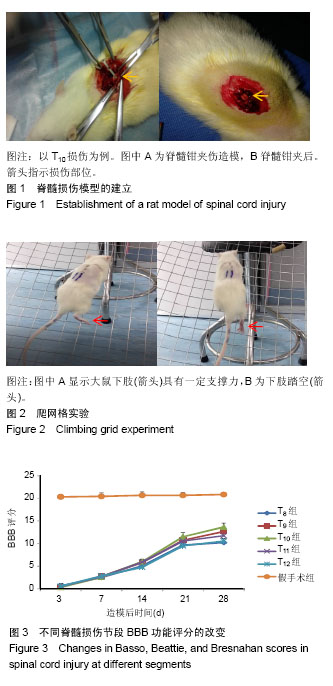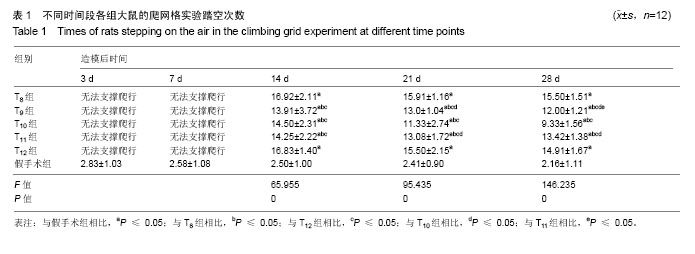| [1] 陈星月,陈栋,陈春慧,等.中国创伤性脊髓损伤流行病学和疾病经济负担的系统评价[J].中国循证医学杂志,2018,18(2):143-150.[2] Kumar R, Lim J, Mekary RA, et al. Traumatic Spinal Injury: Global Epidemiology and Worldwide Volume. World Neurosurg. 2018;113:e345-e363. [3] Singh A, Tetreault L, Kalsi-Ryan S, et al. Global prevalence and incidence of traumatic spinal cord injury. Clin Epidemiol. 2014;6:309-331. [4] Furlan JC, Sakakibara BM, Miller WC, et al. Global incidence and prevalence of traumatic spinal cord injury. Can J Neurol Sci. 2013;40(4):456-464. [5] Moonen G, Satkunendrarajah K, Wilcox JT, et al. A New Acute Impact-Compression Lumbar Spinal Cord Injury Model in the Rodent. J Neurotrauma. 2016;33(3):278-289. [6] 张军,陈晓,张荣佳,等.脊髓损伤动物模型的研究进展[J].中华全科医学,2017,15(3):501-504.[7] 李经辉,刘禹,余化霖.脊髓损伤动物实验模型的研究进展[J].医学综述,2015,21(13):2387-2389.[8] 鲁梦倩.电针对坐骨神经损伤大鼠感觉运动传导通路中GAP-43表达影响的研究[D].北京:北京中医药大学,2013.[9] 李波霖.电针刺激对大鼠受损脊髓节段HIF-1a、VEGF表达影响的研究[D].南宁:广西中医药大学,2016.[10] van Hedel HJ, Curt A. Fighting for each segment: estimating the clinical value of cervical and thoracic segments in SCI. J Neurotrauma. 2006;23(11):1621-1631. [11] Nguyen T, Mao Y, Sutherland T, et al.Neural progenitor cells but not astrocytes respond distally to thoracic spinal cord injury in rat models.Neural Regen Res. 2017;12(11): 1885-1894.[12] Matsumoto M, Ichikawa T, Young W, et al. Glutamine synthetase protects the spinal cord against hypoxia-induced and GABA(A) receptor-activated axonal depressions. Surg Neurol. 2008;70(2):122-128; discussion 128. [13] Snyder EY, Loring JF. Beyond fraud--stem-cell research continues. N Engl J Med. 2006;354(4):321-324. [14] Jones ZB, Ren Y. Sphingolipids in spinal cord injury. Int J Physiol Pathophysiol Pharmacol. 2016;8(2):52-69. [15] Vogelaar CF. Extrinsic and intrinsic mechanisms of axon regeneration: the need for spinal cord injury treatment strategies to address both. Neural Regen Res. 2016;11(4): 572-574. [16] Yu WY, He DW. Current trends in spinal cord injury repair. Eur Rev Med Pharmacol Sci. 2015;19(18):3340-3344. [17] Tedeschi A, Bradke F. Spatial and temporal arrangement of neuronal intrinsic and extrinsic mechanisms controlling axon regeneration. Curr Opin Neurobiol. 2017;42:118-127. [18] 李佳音,李星,肖志峰,等.完全性脊髓损伤再生机制的探讨[J].中国修复重建外科杂志,2018,32(6):641-649.[19] Wang Z, Mehra V, Simpson MT, et al. KLF6 and STAT3 co-occupy regulatory DNA and functionally synergize to promote axon growth in CNS neurons. Sci Rep. 2018;8(1): 12565. [20] West H, Richardson WD, Fruttiger M. Stabilization of the retinal vascular network by reciprocal feedback between blood vessels and astrocytes. Development. 2005;132(8): 1855-1862.[21] 尚云龙,李一帆,宁云峰,等.大鼠脊髓损伤模型的解剖学参考定位[J].解剖学研究,2013,35(6):412-414,481.[22] 张富强,刘玮玮,王克平,等.行为学评价大鼠急性脊髓损伤模型脊髓节段选择的研究[J].世界科技研究与发展, 2015,37(5): 579-583.[23] 王平宇.大白鼠中枢神经系统解剖学[M].北京:人民卫生出版社, 1986.[24] 肖雪飞,李娟娟,黄辉,等.天麻素对脊髓损伤模型大鼠神经功能恢复和胶质纤维酸性蛋白表达的影响[J].中国组织工程研究, 2018, 22(4):558-563.[25] Tas N, Bakar B, Kasimcan MO, et al. Evaluation of protective effects of the alpha lipoic acid after spinal cord injury: an animal study. Injury. 2010;41(10):1068-1074. [26] 张大威,李一帆,朱丹.急性大鼠脊髓损伤模型的建立与评估[J].中风与神经疾病杂志,2015,32(4):325-327.[27] Kaptanoglu E, Tuncel M, Palaoglu S, et al. Comparison of the effects of melatonin and methylprednisolone in experimental spinal cord injury. J Neurosurg. 2000;93(1 Suppl):77-84. [28] Toklu HZ, Hakan T, Celik H, et al. Neuroprotective effects of alpha-lipoic acid in experimental spinal cord injury in rats. J Spinal Cord Med. 2010;33(4):401-409. [29] Kaymaz M, Emmez H, Bukan N, et al. Effectiveness of FK506 on lipid peroxidation in the spinal cord following experimental traumatic injury. Spinal Cord. 2005;43(1):22-26. [30] Emmez H, Yildirim Z, Kale A, et al. Anti-apoptotic and neuroprotective effects of α-lipoic acid on spinal cord ischemia-reperfusion injury in rabbits. Acta Neurochir (Wien). 2010;152(9):1591-1600;discussion 1600-1601. [31] Torres S, Salgado-Ceballos H, Torres JL, et al. Early metabolic reactivation versus antioxidant therapy after a traumatic spinal cord injury in adult rats. Neuropathology. 2010;30(1):36-43. |
.jpg) 文题释义:
钳夹法脊髓损伤模型的建立:暴露椎板直至椎弓根,修整椎板边界并清晰显露硬膜两侧缘,止血满意后持微型血管夹,以其钝性端从硬脊膜与其前方的椎体见穿过至对侧,其后瞬间释放微型血管夹,夹持20 s后松开血管夹,此时可见钳夹处硬脊膜有一明显血肿痕迹,证明造模成功。
脊髓损伤大鼠的应用:实验动物选择的首要原则是其生物学特性是否接近人类。大白鼠具有临床相似度高的特点,同时其成本低,易获取且具备基因被改造的潜能,是目前作为脊髓损伤动物模型最理想的选择。
文题释义:
钳夹法脊髓损伤模型的建立:暴露椎板直至椎弓根,修整椎板边界并清晰显露硬膜两侧缘,止血满意后持微型血管夹,以其钝性端从硬脊膜与其前方的椎体见穿过至对侧,其后瞬间释放微型血管夹,夹持20 s后松开血管夹,此时可见钳夹处硬脊膜有一明显血肿痕迹,证明造模成功。
脊髓损伤大鼠的应用:实验动物选择的首要原则是其生物学特性是否接近人类。大白鼠具有临床相似度高的特点,同时其成本低,易获取且具备基因被改造的潜能,是目前作为脊髓损伤动物模型最理想的选择。.jpg) 文题释义:
钳夹法脊髓损伤模型的建立:暴露椎板直至椎弓根,修整椎板边界并清晰显露硬膜两侧缘,止血满意后持微型血管夹,以其钝性端从硬脊膜与其前方的椎体见穿过至对侧,其后瞬间释放微型血管夹,夹持20 s后松开血管夹,此时可见钳夹处硬脊膜有一明显血肿痕迹,证明造模成功。
脊髓损伤大鼠的应用:实验动物选择的首要原则是其生物学特性是否接近人类。大白鼠具有临床相似度高的特点,同时其成本低,易获取且具备基因被改造的潜能,是目前作为脊髓损伤动物模型最理想的选择。
文题释义:
钳夹法脊髓损伤模型的建立:暴露椎板直至椎弓根,修整椎板边界并清晰显露硬膜两侧缘,止血满意后持微型血管夹,以其钝性端从硬脊膜与其前方的椎体见穿过至对侧,其后瞬间释放微型血管夹,夹持20 s后松开血管夹,此时可见钳夹处硬脊膜有一明显血肿痕迹,证明造模成功。
脊髓损伤大鼠的应用:实验动物选择的首要原则是其生物学特性是否接近人类。大白鼠具有临床相似度高的特点,同时其成本低,易获取且具备基因被改造的潜能,是目前作为脊髓损伤动物模型最理想的选择。


.jpg) 文题释义:
钳夹法脊髓损伤模型的建立:暴露椎板直至椎弓根,修整椎板边界并清晰显露硬膜两侧缘,止血满意后持微型血管夹,以其钝性端从硬脊膜与其前方的椎体见穿过至对侧,其后瞬间释放微型血管夹,夹持20 s后松开血管夹,此时可见钳夹处硬脊膜有一明显血肿痕迹,证明造模成功。
脊髓损伤大鼠的应用:实验动物选择的首要原则是其生物学特性是否接近人类。大白鼠具有临床相似度高的特点,同时其成本低,易获取且具备基因被改造的潜能,是目前作为脊髓损伤动物模型最理想的选择。
文题释义:
钳夹法脊髓损伤模型的建立:暴露椎板直至椎弓根,修整椎板边界并清晰显露硬膜两侧缘,止血满意后持微型血管夹,以其钝性端从硬脊膜与其前方的椎体见穿过至对侧,其后瞬间释放微型血管夹,夹持20 s后松开血管夹,此时可见钳夹处硬脊膜有一明显血肿痕迹,证明造模成功。
脊髓损伤大鼠的应用:实验动物选择的首要原则是其生物学特性是否接近人类。大白鼠具有临床相似度高的特点,同时其成本低,易获取且具备基因被改造的潜能,是目前作为脊髓损伤动物模型最理想的选择。